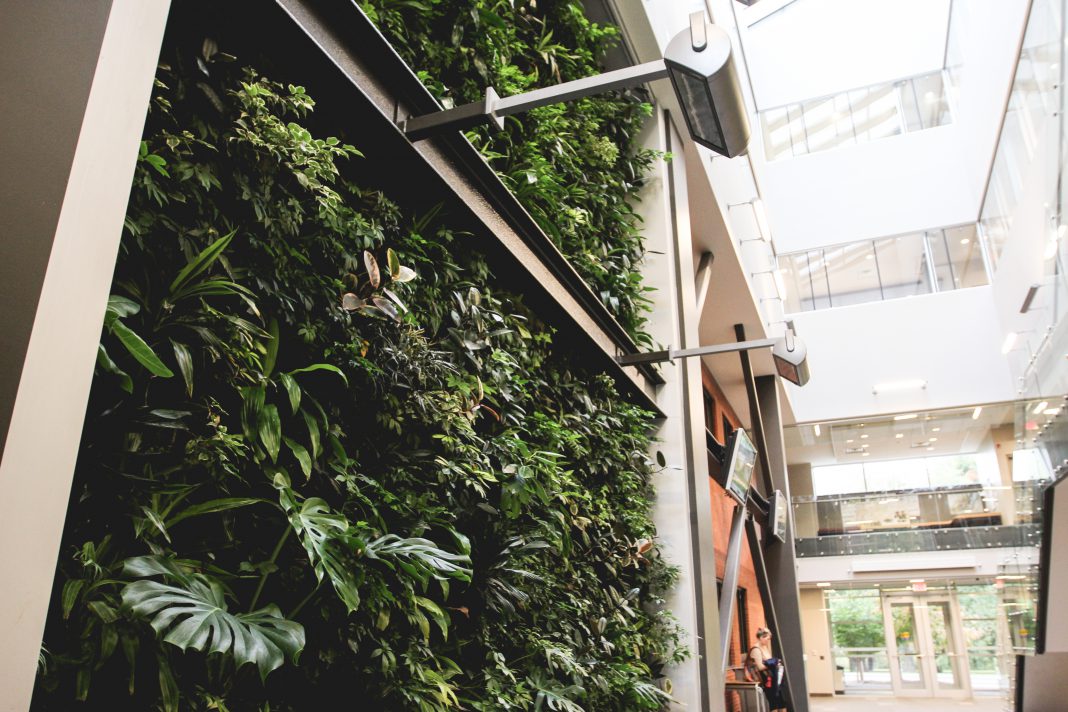As students rush between buildings on their way to class or to join a coffee line, the swell of people, noises, and sometimes smells can be overwhelming and even draining. But there’s an oasis where anyone can breathe deep and listen to the sounds of gently running water — the living wall in Environment 3.
EV 3 is a LEED certified building, which means it incorporates certain environmentally sound building practices within its architecture. By far the most beautiful and soothing aspect of this modern design is the living wall: a giant wall composed entirely of tropical plants and mosses, softly watered by an advanced system, and fed with sunlight through a large skylight.
EV 3 features the largest living wall on campus as well as benches for students to sit back and enjoy it from. A smaller, equally gorgeous installation can be found in EV1.
Looking closely, students can expect to see common household plant varieties such as ficus, schefflera, dracaena, and philodendron.
The living wall was installed and is managed by Nedlaw Industries. Founder and CEO Alan Darlington said that “indoor biofilters such as the ones at the University of Waterloo improve the indoors by integration of natural systems into an otherwise very artificial environment. We use the plant walls as biofilters rather than simple ‘plants on a wall.’”
Darlington went on to explain the benefits of installing living walls in buildings. “Floor space is often limited in most corporate environments, so being able to plant vertically helps save space and also helps water the plants, with gravity pulling the water down through the soil to the plants.”
A common misconception about living walls is that the plants clean the air. For serious biofiltration, the microbes in the soil and not the leaves of the plants do the work. That means traditional office plants are rather lousy at cleaning the air, since their soil microbes are all buried in the pot. Living walls overcome this obstacle, by having the maximum amount of soil exposed to the air, allowing the microbes to do their air cleaning job.
Darlington also pointed out that not every plant is created equal when it comes to biofiltration. The plants Nedlaw Industries selects to install in their living walls are chosen based on four criteria: the plant’s ability to produce lots of microbes in the soil, the ability to grow vertically, sensitivity to changes in environment, and finally, how it will look as part of the overall design of the wall.
As the weather turns colder, the living wall will be subjected to lower temperatures, less sunlight, and less humidity — all keys factors that affect the maintenance of a healthy living wall. Darlington assured that the wall in EV3 should make it through the long winter just fine. “We use supplemental sunlight in the winter months. Plants don’t care where light comes from, they care about the quality of the light,” he said. “We also focus on building up the plants’ resilience during the warmer months to help them get through the winter.”
Living walls are gaining popularity as they can help contribute to lower energy costs pertaining to the conditioning of air in summer and winter months. Biofilters in the living wall help clean the recycled air in the building reducing the need to condition air from outside. The term for this cleaned, recycled air is “virtual outside air.” This is because it’s like fresh new air from outside except it remains indoors and has been cleaned by the biofilters. Darlington said living wall systems can save several hundred dollars per square meter in yearly energy costs.
While most living walls are installed in businesses or large establishments, the future of personal living walls for individual homes is not far away. “We’ve installed in restaurants, animal habitats, even paint shops. We’ve done residential units as well,” said Darlington. Currently, a typical living wall installation can cost between $1,500-$3,000 per square metre.
Until the technology is more popularized in homes, Darlington offered some advice on plants students can afford if they are interested in introducing biofilters to their home: “I recommend matching plants to your lifestyle. The ‘Mother-in-Law Tongue’ or Sansevieria is a great first plant because it needs little attention and is tough. But I also recommend students don’t pick plants just because they clean the air. I have plants because they are so cool. They eat sunshine. There’s nothing cooler than that!”
This article has been corrected to indicate that the living wall installation can cost between $1,500-$3,000 per square metre, rather than square foot.






























